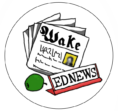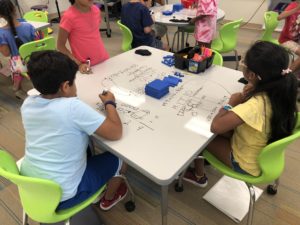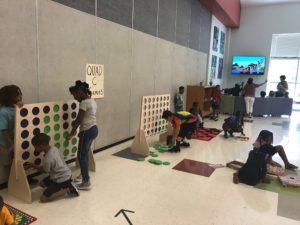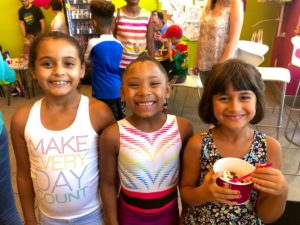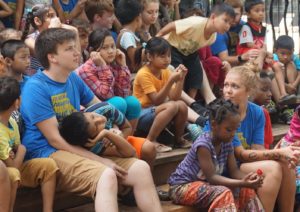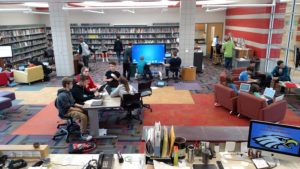Awesome Ideas
This page describes ideas that have the potential to improve student outcomes. We’re interested in ideas that are merely intriguing, those that have been field-tested, and those that have been implemented elsewhere and that we’d like to see here in Wake, based on their results.
Dry-Erase Table Tops
Teachers in some WCPSS schools are letting students respond to prompts by writing their answers right on their desktops. Their desks have been equipped with whiteboard surfaces that can be easily erased. In some cases, teachers allow students to use their smart phones to take pictures of their work and submit answers electronically.
The special desktop surfaces seem to be especially useful for Math lessons, enabling teachers and students to puzzle out a solution and quickly make corrections. Student annotations can explain how the answer was derived–an important aspect of Mathematics instruction under Common Core standards. But they’re also a clever space to conduct lessons in writing–especially revision practice.
Reducing paperwork for teachers while avoiding the use of worksheets as a static tool for learning concepts sounds like a winning formula.
Starting the Day off Right
School leaders are trying a very simple plan to welcome students to Centennial Campus Magnet MS. Students are given large signs and encouraged to display them prominently during morning carpool. The signs have positive messages or just offer free hugs. Seems like a super-inexpensive way to build community.
Just another beautiful morning welcoming our students to school! @CCMMSRedwolves pic.twitter.com/moVbATj48V
— Shannon Bowman (@BowmanCCMMS) July 31, 2019
Flexibility during Lunch
East Garner ES has one of the newer buildings in the county school system, so their cafeteria is mercifully free of institutional-style tables with bolted-on benches.
They’re using the extra space in their lunchroom to provide a kind of playroom where students are still under supervision, but can play board games like checkers or Connect Four, or even relax for a few minutes on comfy sofas with a video game on a big-screen television. Because the school already had the space, they only had to purchase the games or ask for donations. It’s a good way to engage students who finish their meals quickly while still accommodating those who need more time.
Summer Reunions with Former Students
Laura Gassaway of Hortons Creek ES in Cary also has a simple, fun idea to build and maintain relationships with students and their families. At the end of the school year, she informs parents of a midsummer date and time when she’ll be at a local ice cream shop near the school to talk with students about their summer and their plans for the upcoming semester. She used a Google form and emailed it to current and former students, many of whom returned for a second time this summer. By asking families to respond, she was able to build an email list for a reminder closer to time while also making the event seem more official. She also selected a Wednesday to avoid interfering with families’ weekend travel plans. Simple and sweet!
Partnership between Apartment Owner and Schools
The owner of a for-profit apartment complex works closely with the local public schools to provide comprehensive after-school programs for residents. As Linda Johnson reports in EducationDive, Atlanta-area landlord Margaret Stagmeier calls her program “an education model with a housing solution.”
She sees a deep connection between schools and the larger neighborhood and recognizes that it’s a smart business practice to support schools, students, and the local community to shore up real-estate values.
“’It’s hard to get investors to invest in blight,’ she says. ‘And if you have a blighted apartment community, there’s a 100% chance you have a failing school.’”
More info here:
https://www.educationdive.com/news/home-work-atlanta-landlord-provides-after-school-support-to-improve-studen/512534/
Flipped Learning
A “flipped” classroom is one in which the instructor directs the students as they complete tasks that would be considered active learning during class time–tasks that in a more traditional classroom would be completed as homework–while providing online access to videos of lectures to be watched at home.
This approach has the potential to be gimmicky, and to create a huge amount of work for teachers. Producing videos of classroom lectures is surely time-consuming. Does flipping add enough value to make up for its possible shortcomings? We’ve heard that some teachers at Broughton MHS have been trying it out. What do you think: does flipping add enough value to make up for its possible shortcomings?
For more information, see: https://flippedlearning.org/
https://www.edsurge.com/news/2017-10-03-why-flipped-learning-is-still-going-strong-10-years-later
Makerspaces and Other Ways to Transform School Libraries
Big Walnut Middle School (in Sunbury, OH) has an innovative Learning Center that’s the result of a partnership among the school’s principal, a language-arts teacher, and a creative-minded librarian.
More than a hundred students visit the library each day to complete group projects, use the interactive technologies that are easily available, including A/V equipment, and of course, read books. Teachers can send students to the library with a “prescription” that describes what they’re supposed to be working on. Library staff can then not only monitor their activities, but also provide assistance. See https://www.cultofpedagogy.com/school-library/ for more information.
Vandora Springs ES in Garner has a makerspace that includes some jazzed-up building blocks for programmable projects. Makerspaces encourage creativity and revitalize school libraries.
Futsal for Fun
South Garner HS tried out a fun recreational and team-building idea during the Spring semester of the 2018-19 school year: a co-ed, recreational futsal league. Participants paid only $10 to play 3-5 matches.
Futsal is a lot like indoor soccer, but the teams are smaller and walls are not used.
New school, new ideas.
Educators Encouraging Creativity
“Several years ago, as a middle school teacher at a Title I public school in New Haven, Conn., I told my 8th graders that for one period per day, they could spend time solving a problem they cared about instead of doing traditional schoolwork. Doing so changed my classroom: After years of teaching standards, I began teaching students.”
Matt Presser wrote about his experience teaching at a public school for Education Week. Read more of his thoughts about encouraging creativity here: http://www.edweek.org/tm/articles/2017/09/20/educators-should-steal-googles-secret-about-creativity.html?intc=main-mpsmvs
Independent projects are a good way to encourage creative, independent thought, but they are better suited for older students. What are some ways that teachers at your school are encouraging creative, independent thinking? We’d like to hear about them.
“Share Tables” to Reduce Food Waste
Although the practice is more or less illegal in NC after the state Dept. of Health and Human Services severely restricted what can be shared, the use of share tables or bins in schools lets students return unopened food containers and share them with other students free of charge. The concept is simple: a student can simply place an unwanted, uneaten item on the share table, and another student can take it. And as the Orlando-Sentinel reports, at Aloma Elementary School in Orange County, FL, “[w]hatever isn’t picked up by students is donated to a nearby church that gives the food to the homeless.”
It’s encouraging to note that WCPSS has begun using compostable lunch trays at all schools. To those who believe that both hunger and food waste are problems that should also be addressed, DHHS concerns about such practices seem misplaced.
Read about share tables here: https://civileats.com/2017/03/27/school-lunch-share-tables-fight-food-waste-and-hunger/
See also:
A WakeEdNews page of creative or novel ideas for preventing or reducing suspensions: http://wakeednews.com/ideas-for-reducing-suspensions/
